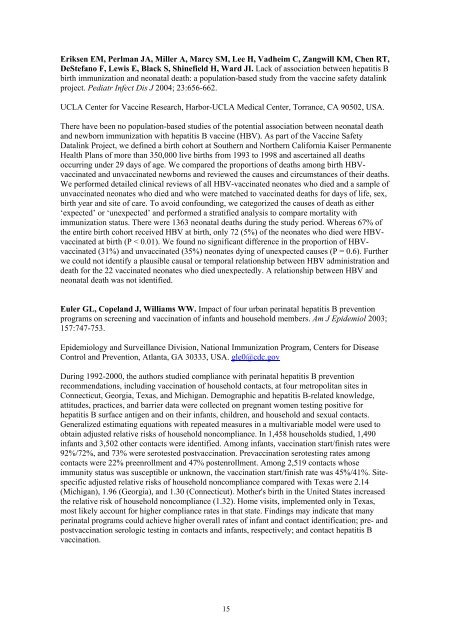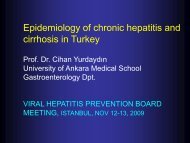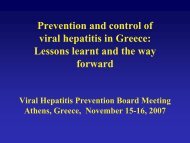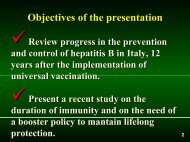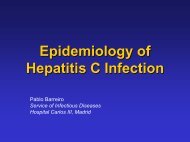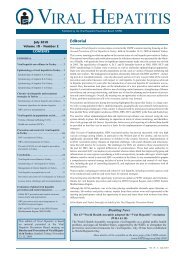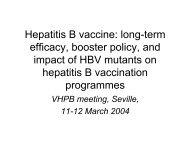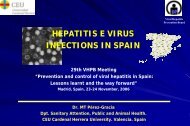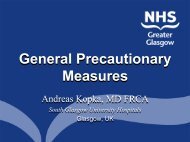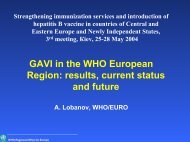Prevention and control of perinatal hepatitis B virus transmission in ...
Prevention and control of perinatal hepatitis B virus transmission in ...
Prevention and control of perinatal hepatitis B virus transmission in ...
You also want an ePaper? Increase the reach of your titles
YUMPU automatically turns print PDFs into web optimized ePapers that Google loves.
Eriksen EM, Perlman JA, Miller A, Marcy SM, Lee H, Vadheim C, Zangwill KM, Chen RT,DeStefano F, Lewis E, Black S, Sh<strong>in</strong>efield H, Ward JI. Lack <strong>of</strong> association between <strong>hepatitis</strong> Bbirth immunization <strong>and</strong> neonatal death: a population-based study from the vacc<strong>in</strong>e safety datal<strong>in</strong>kproject. Pediatr Infect Dis J 2004; 23:656-662.UCLA Center for Vacc<strong>in</strong>e Research, Harbor-UCLA Medical Center, Torrance, CA 90502, USA.There have been no population-based studies <strong>of</strong> the potential association between neonatal death<strong>and</strong> newborn immunization with <strong>hepatitis</strong> B vacc<strong>in</strong>e (HBV). As part <strong>of</strong> the Vacc<strong>in</strong>e SafetyDatal<strong>in</strong>k Project, we def<strong>in</strong>ed a birth cohort at Southern <strong>and</strong> Northern California Kaiser PermanenteHealth Plans <strong>of</strong> more than 350,000 live births from 1993 to 1998 <strong>and</strong> ascerta<strong>in</strong>ed all deathsoccurr<strong>in</strong>g under 29 days <strong>of</strong> age. We compared the proportions <strong>of</strong> deaths among birth HBVvacc<strong>in</strong>ated<strong>and</strong> unvacc<strong>in</strong>ated newborns <strong>and</strong> reviewed the causes <strong>and</strong> circumstances <strong>of</strong> their deaths.We performed detailed cl<strong>in</strong>ical reviews <strong>of</strong> all HBV-vacc<strong>in</strong>ated neonates who died <strong>and</strong> a sample <strong>of</strong>unvacc<strong>in</strong>ated neonates who died <strong>and</strong> who were matched to vacc<strong>in</strong>ated deaths for days <strong>of</strong> life, sex,birth year <strong>and</strong> site <strong>of</strong> care. To avoid confound<strong>in</strong>g, we categorized the causes <strong>of</strong> death as either‘expected’ or ‘unexpected’ <strong>and</strong> performed a stratified analysis to compare mortality withimmunization status. There were 1363 neonatal deaths dur<strong>in</strong>g the study period. Whereas 67% <strong>of</strong>the entire birth cohort received HBV at birth, only 72 (5%) <strong>of</strong> the neonates who died were HBVvacc<strong>in</strong>atedat birth (P < 0.01). We found no significant difference <strong>in</strong> the proportion <strong>of</strong> HBVvacc<strong>in</strong>ated(31%) <strong>and</strong> unvacc<strong>in</strong>ated (35%) neonates dy<strong>in</strong>g <strong>of</strong> unexpected causes (P = 0.6). Furtherwe could not identify a plausible causal or temporal relationship between HBV adm<strong>in</strong>istration <strong>and</strong>death for the 22 vacc<strong>in</strong>ated neonates who died unexpectedly. A relationship between HBV <strong>and</strong>neonatal death was not identified.Euler GL, Copel<strong>and</strong> J, Williams WW. Impact <strong>of</strong> four urban <strong>per<strong>in</strong>atal</strong> <strong>hepatitis</strong> B preventionprograms on screen<strong>in</strong>g <strong>and</strong> vacc<strong>in</strong>ation <strong>of</strong> <strong>in</strong>fants <strong>and</strong> household members. Am J Epidemiol 2003;157:747-753.Epidemiology <strong>and</strong> Surveillance Division, National Immunization Program, Centers for DiseaseControl <strong>and</strong> <strong>Prevention</strong>, Atlanta, GA 30333, USA. gle0@cdc.govDur<strong>in</strong>g 1992-2000, the authors studied compliance with <strong>per<strong>in</strong>atal</strong> <strong>hepatitis</strong> B preventionrecommendations, <strong>in</strong>clud<strong>in</strong>g vacc<strong>in</strong>ation <strong>of</strong> household contacts, at four metropolitan sites <strong>in</strong>Connecticut, Georgia, Texas, <strong>and</strong> Michigan. Demographic <strong>and</strong> <strong>hepatitis</strong> B-related knowledge,attitudes, practices, <strong>and</strong> barrier data were collected on pregnant women test<strong>in</strong>g positive for<strong>hepatitis</strong> B surface antigen <strong>and</strong> on their <strong>in</strong>fants, children, <strong>and</strong> household <strong>and</strong> sexual contacts.Generalized estimat<strong>in</strong>g equations with repeated measures <strong>in</strong> a multivariable model were used toobta<strong>in</strong> adjusted relative risks <strong>of</strong> household noncompliance. In 1,458 households studied, 1,490<strong>in</strong>fants <strong>and</strong> 3,502 other contacts were identified. Among <strong>in</strong>fants, vacc<strong>in</strong>ation start/f<strong>in</strong>ish rates were92%/72%, <strong>and</strong> 73% were serotested postvacc<strong>in</strong>ation. Prevacc<strong>in</strong>ation serotest<strong>in</strong>g rates amongcontacts were 22% preenrollment <strong>and</strong> 47% postenrollment. Among 2,519 contacts whoseimmunity status was susceptible or unknown, the vacc<strong>in</strong>ation start/f<strong>in</strong>ish rate was 45%/41%. Sitespecificadjusted relative risks <strong>of</strong> household noncompliance compared with Texas were 2.14(Michigan), 1.96 (Georgia), <strong>and</strong> 1.30 (Connecticut). Mother's birth <strong>in</strong> the United States <strong>in</strong>creasedthe relative risk <strong>of</strong> household noncompliance (1.32). Home visits, implemented only <strong>in</strong> Texas,most likely account for higher compliance rates <strong>in</strong> that state. F<strong>in</strong>d<strong>in</strong>gs may <strong>in</strong>dicate that many<strong>per<strong>in</strong>atal</strong> programs could achieve higher overall rates <strong>of</strong> <strong>in</strong>fant <strong>and</strong> contact identification; pre- <strong>and</strong>postvacc<strong>in</strong>ation serologic test<strong>in</strong>g <strong>in</strong> contacts <strong>and</strong> <strong>in</strong>fants, respectively; <strong>and</strong> contact <strong>hepatitis</strong> Bvacc<strong>in</strong>ation.15


